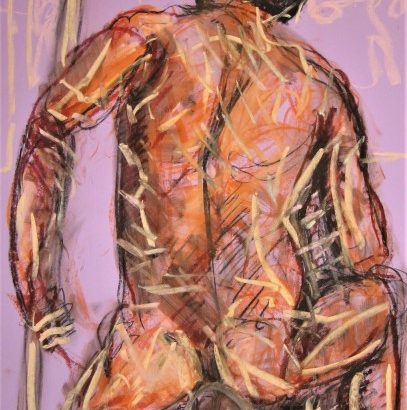DrawBridge: Drawing Alongside My Brother’s Schizophrenia
Caitlin Press, 2019
Stephen A. Corcoran’s art is on display at North Van Arts CityScape Art Rental: https://northvanarts.ca/items/art-rentals/
Art sale proceeds support the Emily Carr University Stephen A. Corcoran Memorial Fund.
Books are available at Canadian libraries, bookstores and on Amazon. Book sale proceeds support The Art Studios where Steve found joyful expression. http://recoverythroughart.ca/ under the auspices of Lookout Housing and Health Society and the Mood Disorder Association of BC.
Reviews, Interviews, You-Tubes
and an Appreciation
“DrawBridge is a daisychain of word associations as Joan brings in skeins of Steve’s history, art history, and the ups & downs of the bonding journey they went on together, she ever hopeful.”
~Margo Lamont, Grind Writers
- North Shore News online version, North and West Vancouver paper: https://www.nsnews.com/community/north-van-author-s-book-charts-brother-s-journey-with-mental-illness-and-art-recovery-1.24037113
- Listen to Joan’s CBC interview with Sheryl MacKay: https://www.cbc.ca/listen/live-radio/1-43-north-by-northwest/clip/15746928-saturday-november-16 between 57:30 and 1:08:30—in the program’s first third.
- Vancouver Sun review by Tom Sandborn (and Postmedia outlets): https://vancouversun.com/entertainment/books/book-review-art-reunites-brother-and-sister-in-touching-family-memoir
- Emily Carr University newsletter: https://www.ecuad.ca/news/2019/where-the-talking-stopped-the-art-began-a-memoir-of-connection-through-creativity
- The Ormsby Review: BC Book World by Janet Nicol https://thebcreview.ca/2019/07/26/584-brother-artist-at-the-edge/
- Q&A with author in ‘Inspired 55+ Lifestyle Magazine’ https://www.seniorlivingmag.com/articles/author-joan-boxall/
- https://dawsonross.wordpress.com/2019/08/19/art-therapy-and-schizophrenia-a-review-of-drawbridge/ Publisher, writer and reviewer, Marvin Ross blogs about his impressions of DrawBridge.
- Margo Lamont of the Grind Writers: https://grindwriters.blogspot.com/2020/01/a-book-appreciation-by-margo-lamont.html
- Listen to Joan’s Vancouver Co-op Radio interview with Bernadine Fox and Dr. Glenn Grigg on FM 100.5 ‘Both Sides Now’ Tues., Feb. 25th, 2020, podcast archived here: https://youtu.be/7B7vTnarxD8
- View of the Corcoran Gallery: https://youtu.be/uFHteCHG2ac (more pieces at North Van Arts Cityscape Gallery, 335 Lonsdale, North Van)
- ‘Make Sense Sestina’ Poets’ Corner Reading Series: https://youtu.be/FYiSZwxFAtU (3-min. reading)
- World Poetry Cafe on Co-op Radio 100.5 FM (from the 15-min. mark) http://www.coopradio.org/content/world-poetry-caf%C3%A9-91?fbclid=IwAR3J4yxIODinkh3i7xwYmjakoVAMi_21HQhkHypQa1qLLo-PO1rLmIj9e0E
QUESTIONS FOR BOOK CLUBS:
- The idea of ‘connecting dots’ is expressed in the Apologia (and by Steve Jobs– on page 11, 15 & 18). Has ‘looking back’ ever helped you connect dots in your life?
- The concepts of ‘praise and blame’ are raised (page 16-18 & 44). How have praise and/or blame been present at varying stages of your life?
- Do you agree that artists are highly sensitive people or HSPs? (page 21)
- How much does making oneself available to strangers change the idea of the ‘other’ as ‘outsider’ and prompt compassion or empathy for those different than ourselves?
- Each essay or chapter is a ‘drawing tool’. Does this add to the story of DrawBridge? Are drawing tools metaphors? Sharpie (page 27) Conte (49) Transfer, Stencil, Collage (60) Charcoal (72) Ruler & Tape Measure (99) Pastels (106-107) Paint (120) Fixative (138) Stump (157) and Kneaded Erasures (166).
- A variety of poetic forms are used in DrawBridge. Poetic segments augment the text as a tool of reflection. Do they enhance or distract in your view?
Poetic Forms:
Chapter 1: Free Form (page 28)
Chapter 2: Free Form (page 49)
Chapter 4: Lipogram (page 64, 69, 72)
Chapter 5: Pantoum (pages 91, 93)
Chapter 6: Blues (101, 103-105, 108, 110)
Chapter 7: Chinese Qu Yuan-style quatrain (124)
Chapter 8: Sestina (129, 130, 132-133, 135, 139)
Chapter 9: Villanelle (147-149, 152)
Chapter 10: Ghazal (161)
7. Do ‘ways of seeing’ (page 37-39, 65-66, 141-142) and Steve’s artistic vision of himself alter the author’s way of seeing herself (page 40)? Do ways of seeing ultimately unite the siblings?
8. How do Art’s seven elements (colour & value, shape & space, texture & form, and line introduced on page 61) become Steve’s new language of artful communication?
9. What are some ways to express artful elements? Do you enjoy colour and texture and form when cooking? Gardening? Playing golf? Going out into nature?
10. What parallels are there between Joan and Steve’s ball games of bocce and their drawing sessions? Brainstorm the non-verbal activities that can be played? (Sports, games, instruments?)
11. What do Gloria and Sylvia air in the dialogue on pages 136-138? What of Kenneth Clark’s distinction between nudity and being naked, page 109?
12. How do Joan and Steve both become representational artists? Mimesis: what has he done? Poiesis: what has she made? (page 158-159) What can one do or make through re-presentation? Representative art embodies reality especially in nature or life. How might this help Steve in his illness?
13. DrawBridge ends with some spidery metaphors (page 167). Have any of your 1-on-1 bridges become webs or networks?
14. What do mental illness and mental health mean to you? Have you ever tried to find mental health support? How hard is it to navigate supports when the mind itself is undermined?
